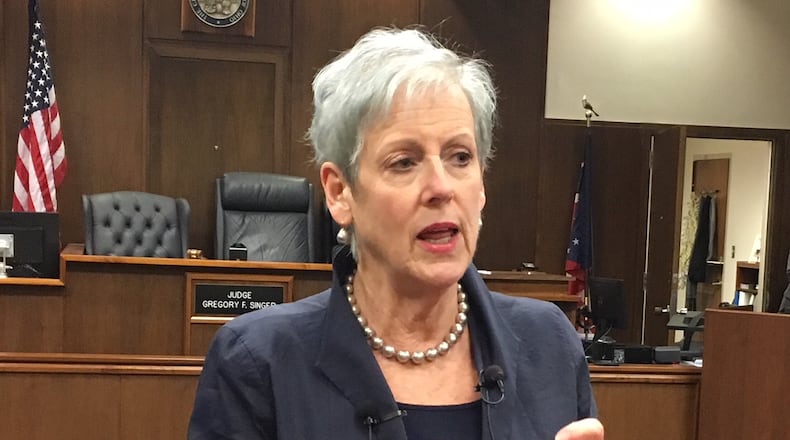In the three-and-a-half years left on her six-year term, O’Connor won’t be silent.
She is already meeting with newspaper editors and state legislators to argue in favor of House Bill 1 and a task force she convened on bail reform is expected to issue a report this month.
DETAILS: City fires administrator after federal bribery, fraud charges
O’Connor, a Republican, has had a ground-breaking career. She has been on the statewide ballot five times and she’s held statewide elected office for 21 years — more than any other woman in Ohio history. She is the second woman to serve as Ohio lieutenant governor and the first woman to serve as chief justice.
House Bill 1 is a measure that would let former offenders apply to seal their criminal records more quickly and expand a program that allows people to side step getting a criminal conviction if they successfully complete drug treatment.
“When people look at someone who is addicted, they don’t see the snowball effect of that addiction on society, but it all culminates in courts. It’s where people go to get relief, where people go for accountability, it’s where people go for help,” O’Connor said. “It’s all centered in the courts.”
Related: Ohio House votes to expand drug treatment options for criminal defendants
Earlier this year, the chief justice also convened a task force to change how Ohio courts set bail for those awaiting their day in court. Traditionally, courts use a cash schedule tied to the criminal charges. Bail has two purposes: make sure the accused show up for court and to protect the public from harm.
Advocates for reform argue that Ohio courts should look at risk factors, not bank accounts, when deciding who goes free on bail and who stays locked up.
O’Connor, who has served on the Conference of Chief Justices and the National Center for State Courts, said over time people have viewed bail as a means of keeping people behind bars — not a way to set terms for release while awaiting court.
Related: Ohio chief justice wants to reform bail system
“The country, for the most part, has taken a long hard look at that and woken up and said, ‘This isn’t what bail is for,’” O’Connor said. “And quite frankly, we can’t afford to do this. Look at all the people we’re housing in jail and all the costs we’re incurring doing that, and to what end?”
Aside from the finances, O’Connor added that, “There is another view to take and that is: Is it moral to lock someone up on a nonviolent offense and have them lose their employment, maybe lose where they live, lose stability of whatever family they may have?”
The task force report is expected later this month for the seven justices to consider.
Advocacy for legislation and policy changes is not new for O’Connor, who has been on the bench since 2003 and became chief justice in 2011.
“The chief justice has had a strong impact on criminal justice issues,” said Daniel Dew of the Buckeye Institute, a conservative think tank. “She is a very forceful advocate for the Ohio criminal justice system. She wants to do what’s best for fundamental fairness.”
Dew, who serves on the bail reform task force, is a legal fellow at the Buckeye Institute.
In her first year leading the court, O’Connor and the Ohio State Bar Association convened a task force to review how capital punishment is administered in Ohio. In 2014, the group put forth more than 50 recommendations — some embraced and others were eschewed by lawmakers.
Related: Capital punishment needs major changes in Ohio, panel says
In February 2014, O’Connor sent instructions to judges across the state to help end the practice of sending people to jail when they owe court fines and are too poor to pay them. The ACLU of Ohio said the new bench card was the first of its kind in the country.
Related: Supreme court issues instructions to end debtors prisons
In 2018, O'Connor issued a stern warning to judges across the state against aggressive assessment and collection of fines and fees against defendants.
“Courts are centers of justice, not automatic teller machines whose purpose is to generate revenue for governments, including themselves,” she wrote.
Jocelyn Rosnick, advocacy director for the ACLU of Ohio, said O’Connor has had a huge impact on criminal justice issues in Ohio and across the nation, especially when addressing practices that criminalize poverty, such as jailing people who are too poor to pay fees or cash bail.
The Ohio Constitution bars O’Connor from running again because she’ll turn 70 during her current six-year term, which ends Dec. 31, 2022.
Her last time on the ballot, O’Connor received nearly 750,000 more votes than President Donald Trump and in 2008, she received 30,000 more votes than President Barack Obama.
Despite decades in public office, O’Connor said she slips by unrecognized at a restaurant or grocery store.
“I’m pretty incognito,” she said.
About the Author

